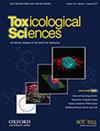DNA adducts form in mouse lung and liver after oral naphthalene exposure.
IF 3.4
3区 医学
Q2 TOXICOLOGY
引用次数: 0
Abstract
Naphthalene is a ubiquitous combustion product and environmental contaminant with known human exposure. Chronic exposure to naphthalene vapor leads to respiratory tumor formation in rodents. Naphthalene forms DNA adducts (precursors to genotoxicity) in tissue explants but it is unclear if this occurs in vivo. Wild-type C57BL/6 mice were orally exposed to 50 mg/kg 14C-naphthalene. Naphthalene-DNA adducts were detected by accelerator mass spectrometry at 2-72 hours post-exposure in both lung and liver, with decreasing abundance over time. Adducts persisted even at 72 hours after exposure, which indicates possible evasion of DNA repair and potential to contribute to mutagenesis.
求助全文
约1分钟内获得全文
求助全文
来源期刊

Toxicological Sciences
医学-毒理学
CiteScore
7.70
自引率
7.90%
发文量
118
审稿时长
1.5 months
期刊介绍:
The mission of Toxicological Sciences, the official journal of the Society of Toxicology, is to publish a broad spectrum of impactful research in the field of toxicology.
The primary focus of Toxicological Sciences is on original research articles. The journal also provides expert insight via contemporary and systematic reviews, as well as forum articles and editorial content that addresses important topics in the field.
The scope of Toxicological Sciences is focused on a broad spectrum of impactful toxicological research that will advance the multidisciplinary field of toxicology ranging from basic research to model development and application, and decision making. Submissions will include diverse technologies and approaches including, but not limited to: bioinformatics and computational biology, biochemistry, exposure science, histopathology, mass spectrometry, molecular biology, population-based sciences, tissue and cell-based systems, and whole-animal studies. Integrative approaches that combine realistic exposure scenarios with impactful analyses that move the field forward are encouraged.
 求助内容:
求助内容: 应助结果提醒方式:
应助结果提醒方式:


